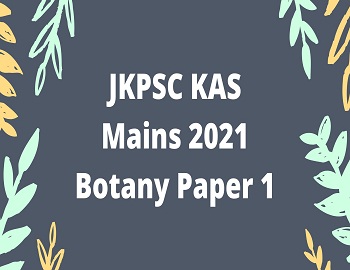JKPSC KAS Mains 2021 Botany Paper 1:
Please read each of the following instructions carefully before attempting the paper.
(i) There are eight questions divided in two Sections and printed in English. Candidate has to attempt Five questions in All. Questions No. 1 and 5 are compulsory and out of the remaining, any Three are to be attempted choosing at least One question from each Section. The number of marks carried by a Question/Part is indicated against it. Answers must be written in English in Question-Cum-Answer (QCA) Booklet in the space provided.
(ii) Your answer should be precise and coherent.
(iii) If you encounter any typographical error, please read it as it appears in the text book.
(iv) Candidates are in their own interest advised to go through the general instructions on the back side of the title page of the Answer Script for strict adherence.
(v) No continuation sheets shall be provided to any candidate under any circumstances.
(vi) No blank page be left in between answer to various questions.
SECTION- A
1. Write short notes in about 150 words.
(a) Mode of multiplication by Transduction method. (10)
(b) Ecological and Economic Importance of Bryophytes. (10)
(c) Tetrapolar Heterothallism. (10)
(d) Salient features of Gnetales. (10)
(e) Define Numerical Taxonomy and mention its Principles. (10)
2. (a) Explain the role of plant quarantine in disease forecasting. Give suitable examples. (20)
(b) Why natural system of classification of Angiosperm is so popular, how this system is different from phylogenetic system of classification. (15)
(c) Give Salient features of Cycadales. (15)
3. (a) Describe the symptoms, causal organisms and control measures of white rust of crucifers and red rot of sugarcane. (20)
(b) Trace the evolution of hexaploid wheat. (15)
(c) Describe Thallus organization in Algae with suitable examples. (15)
4. (a) Explain Stelar evolution in pteridophytes with suitable diagrams. (15)
(b) Define Endosperm, how its development takes place explain with suitable diagram. (15)
(c) Explain protoplast culture. How it is different from tissue culture. (20)
SECTION- B
5. Write short notes in about 150 words.
(a) Orchids and their economic importance. (10)
(b) Somaclonal variation and its applications. (10)
(c) Fungal Toxins. (10)
(d) Ecological and economic importance of Forests. (10)
(e) Economic importance of Algae. (10)
6. (a) Discuss the symptoms, causal organism and disease cycle of any two important diseases caused by nematodes in plants. (20)
(b) Draw well-labelled diagrams of two semi-autonomous organelles in Eukaryotic cells and mention their functions. (15)
(c) How embryo can be rescued, mention its applications also. (15)
7. (a) Explain with schematic diagrams, various types of life cycles in Algae with suitable examples. (20)
(b) Explain Structural variations in chromosomes and its significance. (15)
(c) Define Ecosystem and explain how movement of energy takes place in various trophic levels of the Ecosystem. (15)
8. (a) Give general characteristics of Bryophytes. Enlist the resemblances and differences between bryophytes and pteridophytes. (20)
(b) Define Basal Angiosperms and explain the Herbaceous theory of origin of Angiosperms. (15)
(c) Explain the Importance of Ethnobotany in Indian Context. (15)









Comments (No)